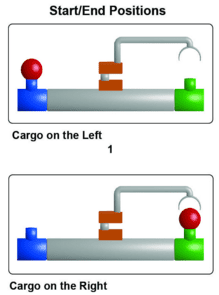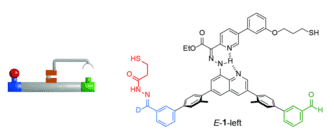
A few months ago we pointed to a very thorough review of artificial molecular machines authored by Prof. David Leigh (winner of the 2007 Feynman Prize in Nanotechnology, Theory category) and three colleagues. Over at ChemistryWorld Simon Hadlington describes recent work from Prof. Leigh’s group using a molecular robot arm to pick up, transport, and release a molecular cargo. “Molecular robot opens the way to nano-assembly lines“:
UK chemists have devised a nanoscale robot that can grasp a cargo molecule, pick it up, place it in a new position some distance away and release it. At no time does the cargo dissociate from the machine or exchange with other molecules. While such a sequence of actions is trivial on a macroscopic scale, to achieve it synthetically with small molecules is unprecedented and could mark the start of a new era of molecular robotics. Multiple similar robots in sequence could, for example, replicate a factory’s assembly line to build increasingly complex molecular structures. …
The research paper was published last month in Nature CHemistry “Pick-up, transport and release of a molecular cargo using a small-molecule robotic arm” [abstract]. The abstract rightly notes that to date the concept of similarly manipulating molecular fragments has only been explored with biomolecular building blocks (specifically structural DNA nanotechnology). This advance implements the concept using small synthetic molecules, with movement provided by inducing conformational and configurational changes within an embedded hydrazone molecular rotary switch.

The sequence of steps is also illustrated on the Leigh Group’s web site “Molecular Robotics“:
… Now chemists at the University of Manchester have made a molecular machine with a ‘robotic arm’ that is able to pick up a molecular cargo, reposition it, set it down and release it at a second site approximately 2 nm (0.000002 mm) away from the starting position … The relocation of molecular fragments with a nanoscale robotic arm—making and breaking chemical bonds in a process during which the cargo is unable to exchange with others in the bulk—is the first step towards the controlled manipulation of molecular-level structures through programmable small-molecule robotics. …
By the way, a few months ago when we pointed to the comprehensive 126-page review of artificial molecular machines by Prof. Leigh and his colleagues, we noted that “Unfortunately, at this writing, it only seems to exist behind a pay wall”. Fortunately, sometime between then and now the review “Artificial Molecular Machines” was changed to an open access article. For those who would like a less comprehensive and more succinct treatment of important aspects of the same topic, Prof. Leigh and another colleague published an open access essay in Angewandte Chemie International Edition last summer “Rise of the Molecular Machines“. Between this small molecule approach and the biomolecular approach we have multiple ways to pursue complex systems of molecular machinery.
—James Lewis, PhD
